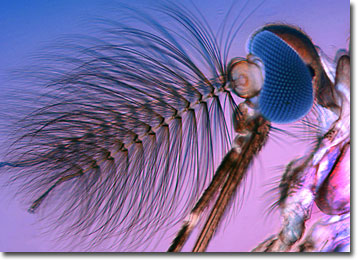Fluorescence Digital Image Gallery
Mosquitoes
Mosquitoes are the small, long-legged insects of the order Diptera infamous for plaguing outdoor recreationists with their bites. Yet, the irritating itching they may cause is little compared to the serious pathogens they may pass on to their victims, which include those that cause malaria, yellow fever, viral encephalitis, filiarsis, and West Nile virus.

Despite the bad reputation of mosquitoes, male mosquitoes do not bite, but harmlessly feed upon plant and fruit juices. It is only the females who require blood meals, due to a need for extra protein to produce eggs. In order to locate their victims, the females utilize a variety of cues, including sight, scent, and heat. From as many as 100 feet away, the insects are capable of detecting the scent of potential hosts, especially the carbon dioxide they exhale. Interestingly, mosquitoes are best at tracking the animals that are most profuse in their environment. Thus, those that inhabit areas such as the Arctic Circle are more apt to feed on native animals like polar bears or caribou, even if humans stumble into their ecosystem.
As pointed out by Michael Crichton in Jurassic Park, mosquitoes have been in existence for more than 100 million years. During that time they have diversified into approximately 3,000 species, which makes it extremely difficult to combat these vector of disease. Despite the creation of a multi-million dollar industry targeting the creatures’ demise, mosquitoes seem to proliferate unabated. This is partially because no product, including pesticides, foggers, mosquito traps, smoking coils, and citronella candles, works equally well on every species of mosquito. Furthermore, the insects are capable of quickly building resistance and over a period of several generations may become completely unaffected by a chemical that was once toxic to them.
BACK TO THE FLUORESCENCE DIGITAL IMAGE GALLERY
